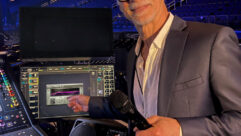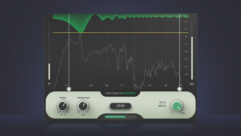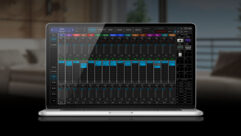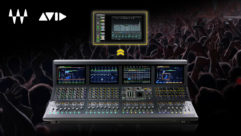Waves are waves
Sep 1, 1999 12:00 PM,
Glen Ballou
A study of the similarities and differences that exist between sound wavesand light waves and some equations to quantify those definingcharacteristics.
We always compare. When we purchase a car, stereo, boat or camera, we lookat how they differ and share common traits. In the field of audio andvisual, it is interesting to compare optics to audio. This does not meanthat we should design optical systems in the same way we design a soundreinforcement system, or vice versa; the comparison here is only used tohelp an audio person understand the optical system in terms familiar toaudio and, conversely, an optical person understand an audio system interms with which he is familiar.
In optics, we talk multi-screen, and in audio, we talk multi-channel.Multi-screen is two, three or more screens or screen areas, and it can berelated directly to multi-channel, stereo or surround sound. In otherwords, the information being presented on each screen or by eachloudspeaker is different, but it must, nevertheless, be related.
In designing a sound system, one of the first things we need to do isdetermine whether the loudspeaker will cover the audience area. One way todetermine this is to lay out the loudspeaker coverage pattern on the planand elevation view of the room to be covered as shown in Figure 1. This canbe done manually or with one of the many programs available, such as EASE.Because the wavelengths of sound are long compared to the length of theloudspeakers producing the sound, sound does not necessarily travel in astraight line as it leaves the loudspeaker. Rather, it bends aroundobjects,including the loudspeaker, particularly at low frequencies. This causesvarying Q and coverage angles of loudspeakers with frequency. Consequently,the analysis must include all the required frequencies of interest, usuallybetween 125 Hz and 8 kHz. Most loudspeaker manufacturers supply coveragepatterns for their loudspeakers. Some supply it at only one frequency anddo not give the dB attenuati!on at the roll-off frequency. The more reputable manufacturers give the coverage at many frequencies and atthe 3 dB, 6 dB and 9 dB levels.
In optics, the wavelength of light is much shorter than the lenses beingused. Therefore, light appears to travel in a straight line, and the Q forlenses does not vary with the various colors we are transmitting. For longscreen-to-film gate distances, Equation 1 (page 30) is used to determineimage width. For short screen-to-film gate distances, such as are used inrear-projection systems in board rooms, the classical lens equation,Equation 2 (page 30), should be used.
In the case of 35 mm slides, image width to image height, or aspect ratio,is 1.5:1; 16 mm motion pictures have an aspect ratio of 1.33:1. Standardvideo has a ratio of 5:4, and HDTV has a ratio of 16:9. It is interestingthat aspect ratios are given with respect to height, although mostprojection charts are related to width.
The equation for the geometric Q of a loudspeaker and lens is the same andcan be found with the equation: where U is the horizontal coverage angle,and F is the vertical coverage angle.
The real Q of a loudspeaker, however, is less than the geometric Q becauseof diffraction, lobing and beaming, which varies with frequency. Optically,the real Q and the geometric Q are about the same, making optical Qmeasurements easier. Loudspeaker Q ranges from 1 to 50, while the optical Qcan range from 14 to greater than 4,000, depending on the lens focal length.
To determine power required to produce the desired SPL in the audiencearea, loudspeaker sensitivity must be known. The loudspeaker sensitivity isgiven by the loudspeaker manufacturer and was determined by energizing itwith 1 W of pink noise and measuring the sound pressure level with a soundlevel meter 4 ft (1 m) from the loudspeaker. The loudspeaker sensitivity isspecified in sound pressure level in dB at 1 W/4 ft (1 W/1 m), Figure 2. Ifwe need an SPL of 100 dB at 1 m, and the loudspeaker has a sensitivity of100 dB/1 W/1 m, we need 1 W to produce the desired SPL. If the loudspeakersensitivity was 97 dB/1 W/1 m, however, we would need 2 W to produce thedesired SPL.
Optically, the sensitivity of a lens or the f/stop of a lens is the ratioof the focal length of the lens divided by the lens diameter. For instance,a 3 inch (76 mm) focal length lens with a 3 inch diameter would be rated asan f/1 lens. A 10 inch (254 mm) focal length lens with an f/1 rating wouldbe 10 inches in diameter. As you can see, a sensitive long focal lengthlens would have to be extremely large to be sensitive. This is why longfocal length lenses are seldom more sensitive than f/3.2. The actual lightoutput differences would be the difference in area between the differentf/stops; therefore, as the f/stops are halved or doubled, the sensitivitychanges by a ratio of four. This is the same equation as used inphotography. If you shoot a picture at 1/30 second at f/5.6, you would haveto change the f/stop to f/4 if you change the speed to 1/60 second.
Efficiency is also an important parameter. A loudspeaker with a 1 W/4 ftsensitivity of 107.47 dB and a Q of 1 would have an efficiency of 100%. Asthe sensitivity of the loudspeaker decreases, so does the efficiency.Efficiency also decreases as the Q of the loudspeaker increases, which isthe reason why low-frequency loudspeakers with low Q and low sensitivitiesare often more efficient than high-frequency horns with high Q and highsensitivities, as shown in Figure 3.
The efficiency of a lens is equal to the light output of the lens beingtested divided by the light output of a perfect lens. The lens being testedwill always be less than perfect because of the quality of the glass fromwhich it is made, which creates some losses, and of reflections off thesurfaces of the lens elements. Good lenses are coated to reduce thisreflection. An uncoated lens may lose as much as 40% of the light output,while a good, coated lens may lose only 5%. For this, reason two differentbrands of f/2 lenses may not have the same efficiency; therefore, lensesused on a multiple screen should be matched for size and light output, asshown in Figure 3.
Once the loudspeaker to be used is determined, the amp power can becalculated by using the equation: where W subscript amplifier is the powerrequired from the amp in watts to produce the desired SPL, program level isthe desired program level in dB; Acoustic level change is the differencebetween the sound pressure level at the farthest listener and the referencedistance in dB, and L subscript sens is the loudspeaker sensitivity at thereference distance in dB.
It is important that the amp power does not exceed the maximum power theloudspeaker is capable of accepting. If the amp power required is greaterthan the power capabilities of the loudspeaker, then either moreloudspeakers or a more efficient loudspeaker must be used to accept thetotal amp power needed to deliver the required SPL. If the loudspeakersensitivity is increased by 3 dB, the amp power can be reduced by 3 dB orcut in half. This is why it is important to use efficient loudspeakers whencovering large areas with sound.
In the optical system, the projector output in lumen is equal to theluminance on the screen times the screen area divided by the screenefficiency and lens efficiency; where Lumens subscript projector is thelumens required at the projector to produce the desired brightness on thescreen; Luminance required is the screen brightness required and iseffected by room light and the subject projected (words require lessbrightness than pictures); Screen area is the area of the screen in squarefeet; % screen efficiency is the amount of light the screen reflects backto the audience (a matte white screen has an efficiency of 100%), and %lens efficiency is the efficiency of a lens relative to a perfect lens of100%; this number is always less than 100%.
In a front-projection system, a matte white screen is considered 100%efficient or has a gain of one, while a beaded or high-gain screen orlenticular screen can have a gain of two to seven on axis. Being passivedevices, screens cannot produce more than they receive, so when the screenis said to have gain, it is only on-axis and falls off to below one offaxis. In rear projection, the on-axis screen gain can vary from 0.5 to 10.Unfortunately, high-gain rear-projection screens have a narrow viewingangle and, therefore, are only used when the audience is one or two peoplein a fixed position. For boardrooms, low-gain, wide-angle screens are used.Efficient lenses, like efficient loudspeakers, mean less power required.Because power is large, heavy and expensive, there is a decided cost andmaintenance advantage in using high-efficiency and low power. If, on theother hand, the extra money is in the budget, and there is enough room toinstall the larger projector, the advanta!ge realized will be a brighter picture. Normally, if a low-sensitivity lens is used, a sharper picture willresult as it is easier to produce a lens with a large number f/stop (smalldiameter) than a lens with a small number f/stop (large diameter).
The final important matter to be determined acoustically is thearticulation loss of consonants in rooms with reverberant times greaterthan 1.6 s and in its simple form is: where, RT60 is the reverberation timein 2 kHz octave band; D2 is the distance between the loudspeaker and thefarthest listener; V is the volume of the room, and Q is the directivity ofthe loudspeaker.
If the loudspeaker Q is too low, the articulation loss will exceed 10%, orwhatever criteria you decide, and the Q will have to be increased. Theloudspeaker Q can be increased by either changing loudspeakers to ones witha narrower coverage pattern or by stacking loudspeakers. Increasing the Qof the loudspeaker may reduce the audience coverage area so that moreloudspeakers are required, reducing articulation. If increasing Q is notpossible, the distance D2 can be reduced, or the RT60 can be reduced.Reducing D2 requires moving the loudspeaker closer to the audience. Thismight reduce the audience coverage area to a point where more loudspeakerswill be required to cover the area, again reducing articulation. ReducingRT60 almost certainly requires the help of an acoustician and a largebudget.
If the ambient sound (noise) is too high, the S/N ratio (signal-to-noise)deteriorates to a point where the ambient noise must be reduced to improveintelligibility to an acceptance level. Reducing noise usually requires theservice of an acoustician.
In projection systems, assuming the optics are of good quality (lowdistortion and minimal aberration), then acceptable viewing quality isbasically determined by two parameters. First, like S/N ratio in sound,ambient light is the culprit in optics. The light that hits the screen andreflects back to the audience reduces intelligibility by reducing picturecontrast. If ambient light hitting the screen is excessive, it must bereduced as increasing projector light output reaches a point of no return -a bright white output from a projector hitting a screen has very littlecontrast with a bright white light being produced by the sun or highintensity lights. One of the main advantages of rear projection is itsability to perform satisfactorily under relatively high ambient light. Itis important, however, that the light be kept away from the screen as muchas possible and imperative that the area behind the screen be as dark aspossible.
The second parameter that produces a poor picture is a low Q lens (manywide angle lenses), which is a short focal length lens. Low Q requires thelight waves to be bent excessively. This reduces sharpness in both frontand rear projection. In front projection with high-gain screens, off-axisseating has greatly reduced brightness. Remember, passive devices cannotproduce gain; so if you have gain head on, you will have reduced gainoff-axis.
In rear-screen installations, a hot spot will appear in the center of thescreen because this is the area where the light waves are bent the least.As the observers move to either side of the room, the hot spot moves withthem and appears where the bend angle is the smallest, and the oppositeside of the screen becomes dark. Increasing the focal length of the lensreduces the hot spot because the light waves are bent less at the screen.This usually increases the edge-to-edge screen brightness and improvespicture quality. Unfortunately, it does require the projection room to bemuch deeper or a system of mirrors must be used. Sometimes high-qualityoptics must be traded off for space.
The third parameter effecting optics is the distance from the projector tothe screen. Like a long D2 reduces the direct SPL by the square of thedistance, long throw projection distances reduce the light output on thescreen by the square of the distance. All things being equal, every timeyou increase the distance between the projector and the screen, youdecrease the light on the screen. Although this can be overcome byimproving the lens optics, the cost will rise considerably.
Nature has only a few rules we must follow. Fortunately for us, the rulesin optics are very much the same as the rules in audio. If we becomeproficient in one, we can also become proficient in the other. All it takesis time and experience.










